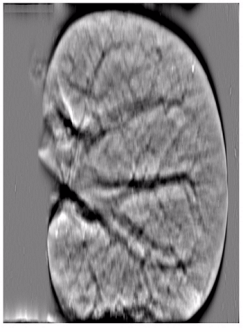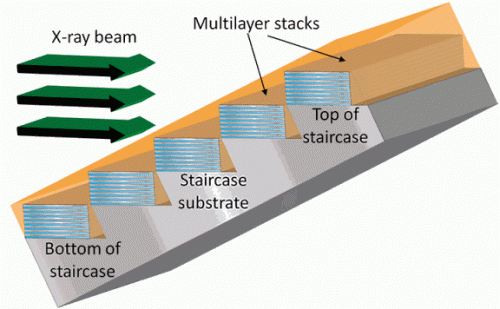A new multilayer-based grating for hard X-ray grating interferometry

(Phys.org) —A new kind of x-ray multilayer grating that could open a pathway for high-sensitivity, hard x-ray phase contrast full-field imaging of large samples has been developed by researchers at the National Institutes of Health, the U.S. Department of Energy Office's (DOE's) Argonne National Laboratory, and Penn State University. In tests at the DOE Office of Science's Advanced Photon Source at Argonne, the device produced phase-contrast images of vascular structures in a mouse kidney specimen that rival those obtained with magnetic resonance imaging. Such soft-tissue structures were previously invisible to conventional attenuation-based x-ray imaging methods.
The new grating, with an ultra-small period and theoretically unlimited depth-to-period ratios, is based on a multilayer thin-film-deposition technique utilizing an anisotropic wet-etched staircase on an off-cut silicon (Si) wafer as the substrate. It has a very small grating period that is equal to the bilayer thickness of the multilayer. It also features a large area of the whole staircase with thousands of steps.
Details of fabrication processes were published in the Journal of Micromechanics and Microengineering . The paper has been selected for inclusion in the Highlights 2012 collection of the journal, based on referee endorsement, novelty, scientific impact, and broad appeal.
Grating-based interferometry for x-ray phase-contrast imaging has advanced rapidly thanks to its potential for better image contrast and lower radiation dose over conventional absorption radiography and computed tomography. Phase-contrast imaging is hundreds of times more sensitive than conventional x-ray imaging techniques based solely on absorption contrast. It is especially useful for imaging soft tissue with hard x-rays from synchrotron light sources like the Advanced Photon Source.
Gratings are used to diffract an incident x-ray beam into two beams that pass through a sample and produce an interference pattern at the detector plane. Variations of the refractive index in the sample lead to a relative difference in the path length, or phase delay, between the interfering beams, which is detectable as a shift of the fringe pattern. Additionally, random scattering of the beams in the sample reduces their mutual coherence, resulting in decreased amplitudes of the interference fringes. A grating interferometer is thus able to detect both x-ray refraction and diffraction in the sample.

A small grating period, which splits and diffracts light into several beams travelling in different directions, will lead to a larger separation between the diffracted beams and thus higher interferometer sensitivity.
Hard x-rays have great penetration power. The interferometer gratings require a sufficient thickness to produce the desired phase shift and absorption. Traditional hard x-ray gratings are fabricated using lithography processes; the grating period is relatively large, and the attainable aspect ratio of the grating is limited.
Multilayer gratings can easily solve the aspect ratio problem. The layers can be as thin as a few nanometers, and the grating can be sliced to many millimeters. However, if a flat substrate is used, the limited height of a single multilayer stack (<50 µm) precludes full-field imaging of large samples.
The new grating with multilayers grown on a staircase substrate, on the other hand, promises both large area detection and small, dense periods. With each stair surface supporting a multilayer as a micro grating and an x-ray beam shining through the layers at an oblique angle to the substrate and parallel to the layer surfaces, the result is a large-area transmission-grating array with small grating periods. This method enables large-area imaging with unprecedented resolution.
Multilayer grating wafers were successfully fabricated at the Advanced Photon Source deposition lab. A 200-nm-period multilayer of tungsten/silicon (W/Si) bilayers was grown on a 20-mm × 20-mm Si staircase substrate with a 28° blaze-angle. The fabricated multilayer grating has a depth-to-period ratio of more than 100:1. The multilayer thickness matches the stair height so that the continuity between adjacent micro-gratings is achieved. A nitride layer was coated before multilayer deposition so that the backside of the Si substrate could be etched away after deposition to reduce x-ray attenuation. The major portion of the multilayer was parallel to the stair surface with a minimal amount on the sidewall. The sample was tilted during multilayer deposition so that the stair surfaces faced the target. Deposition collimators were used to direct the coating flux. Good uniformity of the multilayer was achieved using a profile-coating technique with specific masks made for each sputter gun. A protective epoxy layer was spun onto the multilayer surface after the multilayer was deposited.
Slit diffraction patterns and contact radiography images obtained at the Argonne X-ray Science Division beamline 2-BM-B of the Advanced Photon Source demonstrated successful intensity modulation by the new grating of a 25-keV x-ray beam. Contact radiography showed intensity modulation at a 200-nm period. The slit diffraction pattern showed 69% of the beam energy diffracted into the ±1 and higher diffraction orders. For comparison, a perfect absorption grating diffracts 50% of the beam energy, while an ideal π phase shift grating with no absorption loss diffracts 100% of the beam energy.
"This method opens a pathway for compact x-ray systems to deliver the full benefit of phase contrast to a broad range of applications, such as high-sensitivity x-ray microscopy of pathology specimens that are opaque to optical microscopes, pre-clinical imaging of animal disease models, and non-invasive detection in industrial and material science areas," said Han Wen of the National Heart, Lung, and Blood Institute at National Institutes of Health.
More information: Han Wen, Andrew A. Gomella, Ajay Patel, Susanna K. Lynch, Nicole Y. Morgan, Stasia A. Anderson, Eric E. Bennett, Xianghui Xiao, Chian Liu, and Douglas E. Wolfe, "Subnanoradian X-Ray Phase-Contrast Imaging Using a Far-Field Interferometer of Nanometric Phase Gratings," Nat. Comm. 4, 2659, (November 5, 2013). DOI: 10.1038/ncomms3659
Susanna K. Lynch, Chian Liu, Nicole Y. Morgan, Xianghui Xiao, Andrew A. Gomella, Dumitru Mazilu, Eric E. Bennett, Lahsen Assoufid, Francesco de Carlo, and Han Wen, "Fabrication of 200 Nanometer Period Centimeter Area Hard X-Ray Absorption Gratings by Multilayer Deposition," J. Micromech. Microeng. 22, 105007 (2012). DOI: 10.1088/0960-1317/22/10/105007
Journal information: Journal of Micromechanics and Microengineering
Provided by Argonne National Laboratory




















